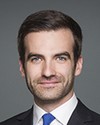Thank you, Mr. Chair.
Madam Clerk, committee members, ladies and gentlemen, I feel privileged to be here today, and I thank the committee for inviting me to speak to this important issue.
I apologize, but I am not proficient enough to give my presentation in French.
I would also like to thank and acknowledge Mr. Paul Calandra for his leadership on this issue of national importance.
I hope I am not redundant, but as a front-line user of protocol, I believe it is an important matter. Protocol, by its definition, is an etiquette or behaviour that demonstrates respect. Many venerable institutions have their own protocols—the Canadian Forces, the Royal Canadian Legion, the RCMP, and many others. However, the Canadian police ceremonial units unanimously believe that national protocol guidelines should be developed and made available to all Canadians.
Since 1985 I have had the honour of serving the Toronto Police Service as its ceremonial sergeant major, and formed at the time one of the first non-military ceremonial units in the country. Now, practically every emergency service throughout this vast land has a group or practice to recognize its fallen and pay homage to them, and also to provide ceremony and dignity to their public and institutional events. The Toronto Police Service participates in approximately 170 ceremonial events annually.
Likewise, as a Canadian army reserve officer, I've had the high honour of participating in over 50 repatriation ceremonies. I've assisted in every aspect of repatriation, from Kandahar to Camp Mirage to the coroner's office in Toronto, through to interment. I have witnessed the incredible professionalism and pride of all involved in making sure that every dignity and respect is paid to our fallen.
I was also dispatched to Haiti following the massive earthquake a few years ago to locate and prepare for the repatriation of two fallen RCMP officers. The process was likewise dignified and respectful throughout.
I've been involved in the planning of far too many funerals here at home, including the ceremony for the late Jack Layton. These tragic events are a reminder to us all of two things: the sacrifice of Canadians, and the fact that Canadians desire and need a method or forum to demonstrate their support and respect for those who have fallen.
Having taken the Highway of Heroes over 50 times, I can tell you that it is an emotionally draining experience. In fact, it is so impactive that I have to share a story with you.
After having lost a comrade-in-arms in Afghanistan, a young soldier from rural Quebec was escorting his friend home. Like most, at the end of his journey he was reduced to tears and emotionally exhausted. He turned to us and said, “Before I was a sovereigntist, now I am a nationalist.” They're very powerful words. The impact of thousands and thousands of everyday Canadians saluting, waving flags, et beaucoup de drapeaux du Québec, was so profound that his attitude to Canadians and Canada had changed.
Canadians have developed our traditions. The Highway of Heroes was one. It was started by a lone Canadian, as I recall, on Little Lake Road bridge with a single flag. With the insistence and determination of Mr. Allan Cole, a witness you will hear from later, this has grown to receive international recognition of how Canadians honour Canadians.
By developing a process that we are addressing here today, ladies and gentlemen, we are in fact defining our identity—in effect, nation-building. We are developing our identity through an energy, enthusiasm, and pride in our country. We are doing it by showing our pride in our Canadian icons, our history, and our traditions.
When I talk about creating a national protocol, it's about institutionalizing our traditions and providing a framework that either does not currently exist or is so obscure that to try to find it may not be worthy of the effort. I am even sure that the House of Commons on occasion has conflict with this.
Many groups and organizations may come before this committee and say there may be no need to codify what we do and how we do it, but I can tell you that we respectfully disagree. I would offer, if I may, a few paradigms that we face.
The first example is during police funerals. These events have become public manifestations of support by both the police force involved and those who wish to demonstrate their solidarity with the fallen officer and the institution of policing. There are many instances where there is disparity, conflict, and inconsistency in how these events are planned and carried out: the placement of flags and flag parties; the order of dress; the conduct of pallbearers; hats on or hats off; casket at the shoulder or the trail; honorary pallbearers; VIP placement; order of precedence; guard of honour, before or after service; who salutes; and the list goes on.
In all of this we must reflect the wishes of the family, the traditions of the service, as well as the established precedents of the profession. Often there is great need to de-conflict these issues, no matter how small. This was extremely evident during the state funeral for the late Jack Layton. Currently there is no national reference by which to accomplish this.
I have witnessed police funerals, for example, that have used 100% American protocols in drill and ceremonial, including folding our flag in a triangle, which I personally feel is an affront to our most cherished national symbol. Currently, there is no official way to fold our Canadian flag. You may find three methods on the Internet, and they're by individual organizations. But the Canadian flag is a symbol of national importance and is owned by the government and people of Canada.
I firmly believe it is up to the people, through its government, to say how we treat our national symbols, for to do otherwise is an abdication of responsibility.
I was at an event last week, which several cabinet ministers and members of Parliament attended, and all our provincial flags were aligned completely out of order. Members were improperly dressed for the occasion, and greetings from the Governor General of Canada were filled with grammatical and spelling errors. This is just common courtesy. It is about respect, as well as nation building, giving Canadians the opportunity to reflect and demonstrate their pride in our country and its icons.
This is as important as changing our anthem or developing a new flag. In the United States, everyone knows they're expected to stand with their hand on their heart during certain occasions: raising of the flag, the oath, and national anthem. But Canadians have no visual method of displaying their respect, and often this American practice can be observed in this country.
The conflict in Afghanistan, our performance in international sport, and Canada's position in the world give every reason for Canadians to be proud. I profoundly believe that Canadians desire a method to appropriately demonstrate their pride, and it is up to the government to show leadership in this regard.
We don't need enforced regulations or laws; we need a comprehensive compendium of guidelines and suggestions on drill, dress, and ceremonial, reflecting the commonality and diversity of Canadians, something that can easily be accessed and used as a reference by individuals and organizations, and it should reflect our history, traditions, and legacy, but also look to the future and provide flexibility in its application.
Thank you very much. Merci beaucoup.




